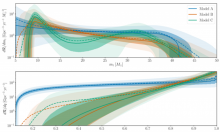
Abstract
We present results on the mass, spin, and redshift distributions with phenomenological population models using the 10 binary black hole (BBH) mergers detected in the first and second observing runs completed by Advanced LIGO and Advanced Virgo. We constrain properties of the BBH mass spectrum using models with a range of parameterizations of the BBH mass and spin distributions. We find that the mass distribution of the more massive BH in such binaries is well approximated by models with no more than 1% of BHs more massive than 45  and a power-law index of α =
and a power-law index of α =  (90% credibility). We also show that BBHs are unlikely to be composed of BHs with large spins aligned to the orbital angular momentum. Modeling the evolution of the BBH merger rate with redshift, we show that it is flat or increasing with redshift with 93% probability. Marginalizing over uncertainties in the BBH population, we find robust estimates of the BBH merger rate density of R =
(90% credibility). We also show that BBHs are unlikely to be composed of BHs with large spins aligned to the orbital angular momentum. Modeling the evolution of the BBH merger rate with redshift, we show that it is flat or increasing with redshift with 93% probability. Marginalizing over uncertainties in the BBH population, we find robust estimates of the BBH merger rate density of R =  Gpc−3 yr−1 (90% credibility). As the BBH catalog grows in future observing runs, we expect that uncertainties in the population model parameters will shrink, potentially providing insights into the formation of BHs via supernovae, binary interactions of massive stars, stellar cluster dynamics, and the formation history of BHs across cosmic time.
Gpc−3 yr−1 (90% credibility). As the BBH catalog grows in future observing runs, we expect that uncertainties in the population model parameters will shrink, potentially providing insights into the formation of BHs via supernovae, binary interactions of massive stars, stellar cluster dynamics, and the formation history of BHs across cosmic time.